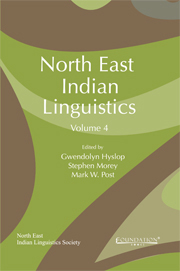Book contents
- Frontmatter
- Contents
- About the Contributors
- Foreword
- A Note from the Editors
- History, Contact and Evolution
- Bodo-Garo Grammar
- Orthography, Poetics and Text
- New Descriptions
- Classifiers
- 12 Classifiers in Mising
- 13 On Classifiers in Asamiya
- 14 Classifiers in Assamese: Their Grammar and Meaning Chains
- Eastern Indo-Aryan Grammar
- Austroasiatic
14 - Classifiers in Assamese: Their Grammar and Meaning Chains
from Classifiers
Published online by Cambridge University Press: 05 May 2013
- Frontmatter
- Contents
- About the Contributors
- Foreword
- A Note from the Editors
- History, Contact and Evolution
- Bodo-Garo Grammar
- Orthography, Poetics and Text
- New Descriptions
- Classifiers
- 12 Classifiers in Mising
- 13 On Classifiers in Asamiya
- 14 Classifiers in Assamese: Their Grammar and Meaning Chains
- Eastern Indo-Aryan Grammar
- Austroasiatic
Summary
Introduction
The present chapter dicusses the grammar and meaning of classifiers in Assamese. In §2, we discuss classifier grammar, showing that the basic grammatical function of classifiers in Assamese is to unitize or individuate the noun to facilitate numerical quantification. They are thus numeral classifiers. In §3, we first identify the classifiers in Assamese, together with the semantic parameters they employ to categorize noun referents. The remainder of §3 then focuses on the meaning chains classifiers exhibit, showing how they extend their basic meaning in numerous ways so that they can categorize an open-ended class of noun referents which are apparently rather diverse and unrelated. The discussions in §2 and §3 are followed by our concluding remarks.
The grammatical functions of classifiers in Assamese
This section discusses the grammatical functions that classifiers in Assamese perform.
Classifiers and the object-mass distinction
A noun designates a kind of things, rather than an instance of the kind. Thus, for instance, the English word dog does not intrinsically refer to any particular dog; rather, it refers to a particular kind of animal. Now, in terms of ordinary human perception, kinds are of at least two types: a kind may refer either to a set of similar discrete objects, as with dog; or, it may refer to an unsegmented mass, as with water. In a language like English, the grammar is immediately sensitive to the distinction between these two types of kinds: the object-mass distinction.
- Type
- Chapter
- Information
- North East Indian Linguistics , pp. 292 - 314Publisher: Foundation BooksPrint publication year: 2012
- 1
- Cited by



